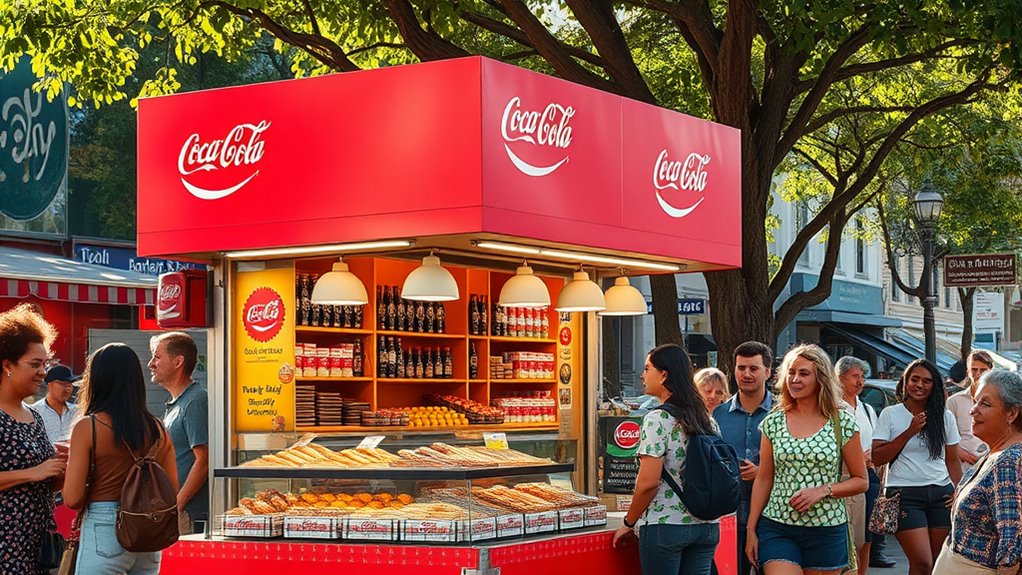Cross-brand promotions with local businesses let you boost visibility, reach new audiences, and strengthen community ties. By combining branding efforts, organizing joint events, and sharing marketing resources, you create memorable experiences that engage customers and build trust. Offering incentives like discounts encourages collaborations and increases sales for both partners. Want to discover more effective strategies to make these partnerships truly successful? Keep exploring to unearth additional ideas and tips tailored to your goals.
Key Takeaways
- Collaborate on joint marketing campaigns to expand reach and attract new audiences.
- Organize co-branded events like tastings or workshops to increase engagement and brand visibility.
- Share promotional materials and signage to reinforce a unified brand message locally.
- Offer incentives such as discounts for combined purchases to motivate customer participation.
- Leverage social media and community channels to highlight partnerships and foster customer trust.

Partnering with local businesses for cross-brand promotions can considerably boost your visibility and customer engagement. When you align with nearby companies, you create opportunities to reach new audiences and strengthen your brand presence. One effective way to do this is by implementing co branding strategies that leverage the strengths of each partner. These strategies involve combining your branding efforts to produce a unified message, making your promotion more memorable and impactful. Co branding strategies can range from shared logos on promotional materials to co-branded events, helping both brands stand out in a crowded marketplace.
Partnering with local businesses through co-branding boosts visibility and customer engagement.
To maximize the benefits, you should consider running joint marketing campaigns that are tailored to appeal to both your existing customers and the target market of your partner business. For example, if you own a coffee shop and partner with a nearby bookstore, you might create a campaign offering discounts to customers who purchase both a book and a coffee. These joint marketing campaigns don’t just increase sales; they also enhance brand association, making your business seem more community-oriented and approachable. When executed well, these campaigns foster a sense of partnership and shared purpose that customers appreciate.
The key to successful cross-brand promotions lies in identifying complementary businesses that align with your brand values and target audience. Think about what your customers need or enjoy, and find a local business that can add value to their experience. Once you establish the partnership, coordinate your messaging carefully. Consistent branding and clear communication are essential to guarantee that your joint marketing efforts resonate. Use social media, email newsletters, and in-store signage to promote the collaboration, highlighting the benefits for your customers.
Additionally, consider creative ways to make these collaborations stand out. Host a joint event, like a tasting, workshop, or community day, that showcases both brands and encourages direct interaction. These events not only generate buzz but also deepen relationships with your customers. Remember, the success of cross-brand promotions depends on genuine partnerships built on mutual trust and shared goals. When both parties actively promote the initiative, it leads to greater exposure and more meaningful engagement.
Ultimately, by thoughtfully integrating your marketing efforts with local businesses through co branding strategies and joint marketing campaigns, you position yourself as a key player in your community. This collaborative approach not only boosts your brand’s visibility but also fosters loyalty and trust among your customers, paving the way for sustained growth and success. Additionally, leveraging AI tools can help optimize your marketing strategies and reach a broader audience more efficiently.
Frequently Asked Questions
How Do I Measure the Success of Cross-Brand Promotions?
You measure the success of cross-brand promotions by analyzing metrics and customer engagement. Track key metrics like sales increases, website traffic, and social media interactions to see how customers respond. Use surveys or feedback forms to gauge customer engagement levels. Comparing pre- and post-promotion data helps you understand impact. Monitoring these metrics regularly allows you to refine your strategies, ensuring future promotions drive better results and stronger brand partnerships.
What Legal Considerations Are Involved in Local Business Collaborations?
You need to be a legal superhero when collaborating with local businesses! Draft clear contract agreements to define each party’s roles, responsibilities, and revenue sharing, preventing chaos later. Protect your intellectual property—trademarks, logos, and proprietary content—by including specific clauses. Always guarantee compliance with local laws and regulations to avoid legal pitfalls. Consulting a lawyer for these agreements is your secret weapon to safeguard your brand and foster smooth partnerships.
How Can I Ensure Brand Consistency Across Partners?
You can guarantee brand consistency across partners by establishing clear brand guidelines that emphasize brand alignment and messaging coherence. Communicate these standards upfront and provide shared resources like logos and tone of voice documents. Regularly review collaborations to ensure both parties adhere to the agreed-upon standards. This proactive approach helps maintain your brand’s integrity, fosters trust, and ensures a unified presence in all cross-brand promotions.
What Is the Ideal Duration for a Cross-Brand Campaign?
You should aim for a campaign timeline of 4 to 6 weeks, as it allows enough time to build momentum and maximize audience engagement. Shorter campaigns might not produce lasting impact, while longer ones risk fatigue. Focus on consistently engaging your audience throughout this period, adjusting your strategy if needed. This balance ensures your cross-brand promotion remains fresh, impactful, and memorable for your target audience.
How Do I Select the Right Local Businesses for Partnerships?
Think of selecting local partners like matchmaking—look for businesses whose target audience aligns with yours. Prioritize partnership criteria like shared values, complementary products, and community reputation. For example, I once teamed up with a local coffee shop that attracted your ideal demographic, boosting both our visibility. Focus on these criteria, and you’ll find partners who genuinely enhance your brand’s reach and credibility, creating a win-win for everyone involved.
Conclusion
Partnering with local businesses through cross-brand promotions can boost your visibility and strengthen community ties. Did you know that 70% of consumers feel more loyal to brands that support local initiatives? By collaborating, you not only attract new customers but also foster trust and goodwill. Take advantage of these opportunities to create meaningful connections—your business and community will thrive together. Embrace local partnerships, and watch your brand grow stronger every day.









